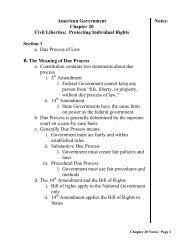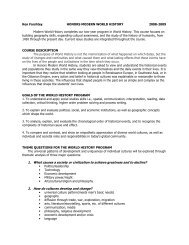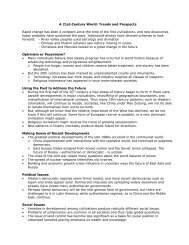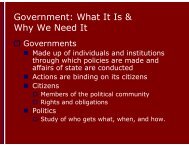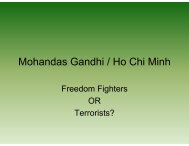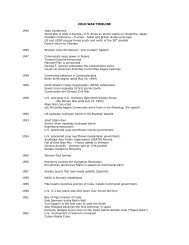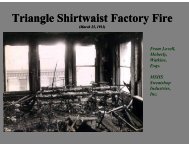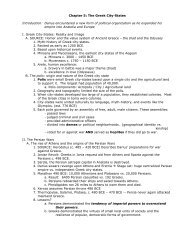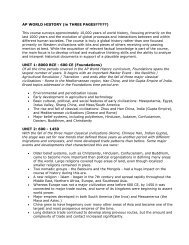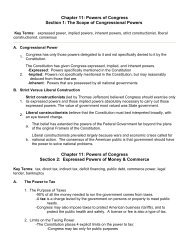The Mass Media and American Politics
The Mass Media and American Politics
The Mass Media and American Politics
Create successful ePaper yourself
Turn your PDF publications into a flip-book with our unique Google optimized e-Paper software.
<strong>The</strong> <strong>Mass</strong> <strong>Media</strong><strong>and</strong> <strong>American</strong> <strong>Politics</strong>
<strong>The</strong> U.S. <strong>Media</strong> Today• Print media: traditional form of mass media,comprising newspapers, magazines, <strong>and</strong>journals.• Electronic media: the broadcast <strong>and</strong> cablemedia, including television, radio, <strong>and</strong> theInternet.
National Influence of the <strong>Media</strong>• Only a h<strong>and</strong>ful of media outlets are influential nationally.– New York Times– Wall Street Journal– USA Today– Christian Science Monitor– Washington Post– Los Angeles Times• <strong>The</strong>y have reach through their own circulation, but alsoinfluence what the five major national networks <strong>and</strong> cablenews organizations decide to focus on.• Wire services also nationalize the news• News magazines also supplement these other sources.– Time, Newsweek, U.S. News <strong>and</strong> World Report
• <strong>Mass</strong> <strong>Media</strong>:– Television, radio, newspapers,magazines, the Internet <strong>and</strong> othermeans of popular communication• High-Tech <strong>Politics</strong>:– A politics in which the behavior ofcitizens <strong>and</strong> policymakers <strong>and</strong> thepolitical agenda itself areincreasingly shaped by technology
<strong>The</strong> <strong>Mass</strong> <strong>Media</strong> Today• Effective communication through media is key topolitical success.– <strong>Media</strong> Events: events purposely staged for themedia that nonetheless look spontaneous• <strong>Media</strong> events can be staged by almost anybody.– 60% presidential campaign spending is TV ads• Two-thirds is negative.– Image making <strong>and</strong> news management is important,especially for presidents.
<strong>The</strong> Development of <strong>Media</strong> <strong>Politics</strong>• Introduction– <strong>The</strong> news media wasn’t always so important.– Press Conferences: meetings of public officials withreporters• Franklin Roosevelt held over 1,000– Investigative Journalism: the use of in-depth reportingto unearth sc<strong>and</strong>als, scams & schemes putting reporters& politicians opposite each other– Coverage of presidential c<strong>and</strong>idates has become lessfavorable.
<strong>The</strong> Development of <strong>Media</strong> <strong>Politics</strong>• <strong>The</strong> Print <strong>Media</strong>– Newspapers <strong>and</strong> magazines– “Yellow journalism”: a sensational style ofreporting characterized newspapers at the turnof the century– Pecking order among newspapers• New York Times has largest impact– Newspaper <strong>and</strong> newsweekly circulation hasdeclined
<strong>The</strong> Development of <strong>Media</strong> <strong>Politics</strong>• <strong>The</strong> Broadcast <strong>Media</strong>– Television <strong>and</strong> radio– Brought government <strong>and</strong> politics into peoples’homes• Vietnam War– Politicians’ appearance <strong>and</strong> mannerisms moreimportant• Kennedy-Nixon presidential debate
<strong>The</strong> Development of <strong>Media</strong> <strong>Politics</strong>• Government Regulation of the Broadcast<strong>Media</strong>– <strong>The</strong> Federal Communications Commission(FCC) regulates the use of airwaves in threeways:• Prevent near monopoly control of market• Reviews performance of stations• Issues fair treatment rules for politicians
<strong>The</strong> Development of <strong>Media</strong> <strong>Politics</strong>• From Broadcasting to Narrowcasting: <strong>The</strong>Rise of Cable News Channels– Narrowcasting: media programming on cableTV or Internet that is focused on one topic <strong>and</strong>aimed at a particular audience, e.g., C-SPAN– Potential of cable to report on news as ithappens <strong>and</strong> offer myriad choices– Yet, resources are limited <strong>and</strong> stories are notsubstantive
<strong>The</strong> Development of <strong>Media</strong> <strong>Politics</strong>• <strong>The</strong> Impact of the Internet– Potential to inform <strong>American</strong>s about politics– Internet is purposive—people choose what tolearn about– Since <strong>American</strong>s are generally disinterested inpolitics, they will not necessarily use theInternet for political information.– Blogs provide additional information aboutnews stories.
• Radio– Prominent 1930s-50s– FDR Fireside Chats– Now very little news coverage– Talk Programs• Dominated by conservativetalk hosts– Rush Limbaugh– Sean Hannity• Television– 57% of <strong>American</strong>s watch nightlynews– Considered most trusted newssource– Younger <strong>American</strong>s get news <strong>and</strong>information from late night talkshows <strong>and</strong> news parodies• Leno• Letterman• Stephen Colbert• Jon StewartBroadcast
• 23% of <strong>American</strong>s gettheir news from theinternet <strong>and</strong> number isgrowing• 75% of young<strong>American</strong>s prefer theinternet as source ofnews <strong>and</strong> politicalinformation– YouTube– Blogs (Daily Kos)Internet
<strong>The</strong> Development of <strong>Media</strong><strong>Politics</strong>• Private Control of the <strong>Media</strong>– Only a small number of TV stations arepublicly owned in America.– Independent in what they can report, media aretotally dependent on advertising revenues.– Chains: massive media conglomerates thataccount for over four-fifths of the nation’s dailynewspaper circulation• Also control broadcast media
Covering the Presidency• President is the focus of the most media coverage.– Can summon the press at will– FDR was the first to use the press conference as ameans to shape public opinion <strong>and</strong> explain his actions.• Press Secretary: existed since Hoover’s administration.– President’s main disseminator of information to thepress– President gets the most coverage, but much of it isnegative– G.W. Bush record low number of press conferences• Strategy to control his image
Covering Congress• Size of Congress <strong>and</strong> its decentralized nature make itdifficult for the media to cover it.• Solve this problem by– Giving leaders most attention– Key committee chairs comm<strong>and</strong> center stage– Local newspapers <strong>and</strong> broadcast stations normallydevote some resources to covering their ownrepresentatives• Coverage tends to be negative.– Focus on conflict– May be part of the reason people view Congress sonegatively• Investigative hearings may be televised.– Joseph McCarthy– Enron <strong>and</strong> World.com
Investigative Journalism<strong>and</strong> the Character Issue• Here reporters go beyond headlines <strong>and</strong>scrutinize public officials <strong>and</strong> public policyin order to find wrongdoing.• Watergate– Woodward <strong>and</strong> Bernstein• New York Times Co. v. Sullivan (1964)
Libel <strong>and</strong> Sl<strong>and</strong>er• 1 st Amendment does not protect false statements that causedamage– Libel is written– Sl<strong>and</strong>er is spoken• Generally must prove– Statement False– Causes Damages• Individuals in public eye must prove– Statement False– Causes Damages– Made with Malice or Reckless Disregard of the Truth• Parodies are not subject to defamation suits– Hustler Magazine v. Falwell– Mad TV <strong>and</strong> Saturday Night Live
Reporting the News
Reporting the News• Presenting the News– Superficial describes most news coverage today.– Sound Bites: short video clips of approximately 10seconds– Major TV networks devote less time to coveringpolitical c<strong>and</strong>idates.
Reporting the News• Bias in the News– Many people believe the news is biased in favorof one point of view.– Generally are not very biased toward aparticular ideology– News reporting is biased towards what willdraw the largest audience; good pictures <strong>and</strong>negative reporting
Reporting the News
<strong>The</strong> News <strong>and</strong> Public Opinion• Television news can affect what peoplethink is important.– Agenda-setting effect• <strong>The</strong> media influence the criteria by whichthe public evaluates political leaders.• Some stories or events can be made moreimportant, others less important, dependingon their coverage.
<strong>The</strong> <strong>Media</strong>’s Agenda-SettingFunction• Policy Agenda: the issues that attract theserious attention of public officials <strong>and</strong>other people actively involved in politics atthe time• Policy Entrepreneurs: people who investtheir political “capital” in an issue to get itplaced high on governmental agenda– Use media to raise awareness of issue
Underst<strong>and</strong>ing the <strong>Mass</strong><strong>Media</strong>• <strong>The</strong> <strong>Media</strong> <strong>and</strong> the Scope of Government– <strong>Media</strong> as watchdog restricts politicians– New proposals are met with skepticism whichrestricts scope of government, what it can do– If media identify a problem, force governmentto address it, which exp<strong>and</strong>s the scope ofgovernment
Underst<strong>and</strong>ing the <strong>Mass</strong><strong>Media</strong>• Individualism <strong>and</strong> the <strong>Media</strong>– C<strong>and</strong>idates run on their own by appealing to people ontelevision– Easier to focus on one person like the president, thangroups, e.g., Congress or the courts• Democracy <strong>and</strong> the <strong>Media</strong>– “Information is the fuel of democracy.”– But news provides more entertainment thaninformation; it is superficial.– News is a business, giving people what they want.
<strong>The</strong> News Generation Gap
<strong>The</strong> Public’s Perception of the <strong>Media</strong>• Public opinion of media is relatively critical.• Perceive media to be– Politically biased– Roadblocks to solving problems– Inaccurate in their reporting– Unwilling to admit mistakes• Most still view the national news media as credible• Terrorist attacks shifted public opinion positively for aperiod• Value the watchdog role of the news media
Top Problems Facing Journalism
Regulation of the Broadcast <strong>Media</strong>• Federal Radio Act• Federal Communications Act– Federal CommunicationsCommission– Broadcast Licenses– Renewed– Traditionally limited number ofstations owned, but has sincebeen relaxed• In FCC v. Pacifica Foundation, USSupreme Court extend regulatorypower to include offensive broadcast– Georg Carlin’s Seven DirtyWords– Super Bowl WardrobeMalfunction• Satellite subscription broadcastsgranted greater latitude rebroadcasts– Howard Stern on Sirius– Soprano’s on HBO
Political Broadcast Rules• Equal Time Requirement– Must offer to sale equal time to political campaigns– Does not apply to news broadcasts or talk show hosts• Right of Rebuttal– Gives target of investigative report the opportunity to rebutallegations– Generally a no comment or did return phone calls• Fairness Doctrine– Gives opposing points of view– Repealed during Reagan on grounds chilled free speech• Shield Laws– Protects reporters from revealing sources– Traditionally, jailed for contempt for failing to identifyunnamed or confidential sources
Internet Regulation• Internet is acombination of print <strong>and</strong>broadcast media– If print, then protected bythe 1 st Amendment– If broadcast, governmenthas greater regulatorypower• Courts have haddifficulty in determiningthe extent to which theinternet can be regulated– Adult Sites– Virtual Child Porn– Gambling
Efforts to Regulate <strong>Media</strong> Practices• In the U.S., only government officials canbe prosecuted for divulging classifiedinformation.– No such law exists for journalists.– Nor can the government, except underextremely rare circumstances, impose priorrestraints on the press.
<strong>The</strong> <strong>Media</strong> Industry Profits <strong>and</strong> <strong>Politics</strong>• Advertising provides the profits for corporatemedia– Audience size is critical– Determines Ad rates• <strong>American</strong> Idol $700,000 for 30seconds• Desperate Housewives $500,000 for30 seconds• Super Bowl $2.7 million for 30seconds– Ratings• Nielsen for TV• Arbitron for Radio• Subscription/Circulation rates fornewspapers <strong>and</strong> magazines• Web sites measure hits– <strong>Media</strong> compete for market share• Product must attract large audiencesto sell to advertisers• Push sensationalism <strong>and</strong> sc<strong>and</strong>als• Yellow journalism <strong>and</strong> muckraking• Investigatory journalism
<strong>Media</strong> Bias <strong>and</strong> the C<strong>and</strong>idates• Fox News <strong>and</strong> Obama– Repeated broadcasts depicting orinsinuating that Obama is Muslim or un-<strong>American</strong>– Led to website created to attack theattacks• MSNBC <strong>and</strong> John McCain– Olbermann, Matthews removed fromdebate coverage following “partisan”critiques of conventions
Summary• <strong>Media</strong> shape public opinion on politicalissues <strong>and</strong> influence policy agenda.• Broadcast media have replaced print mediaover time.• Narrowcasting <strong>and</strong> the Internet are furthershifting media.• Seeking profits, media are biased in favor ofstories with high drama.




